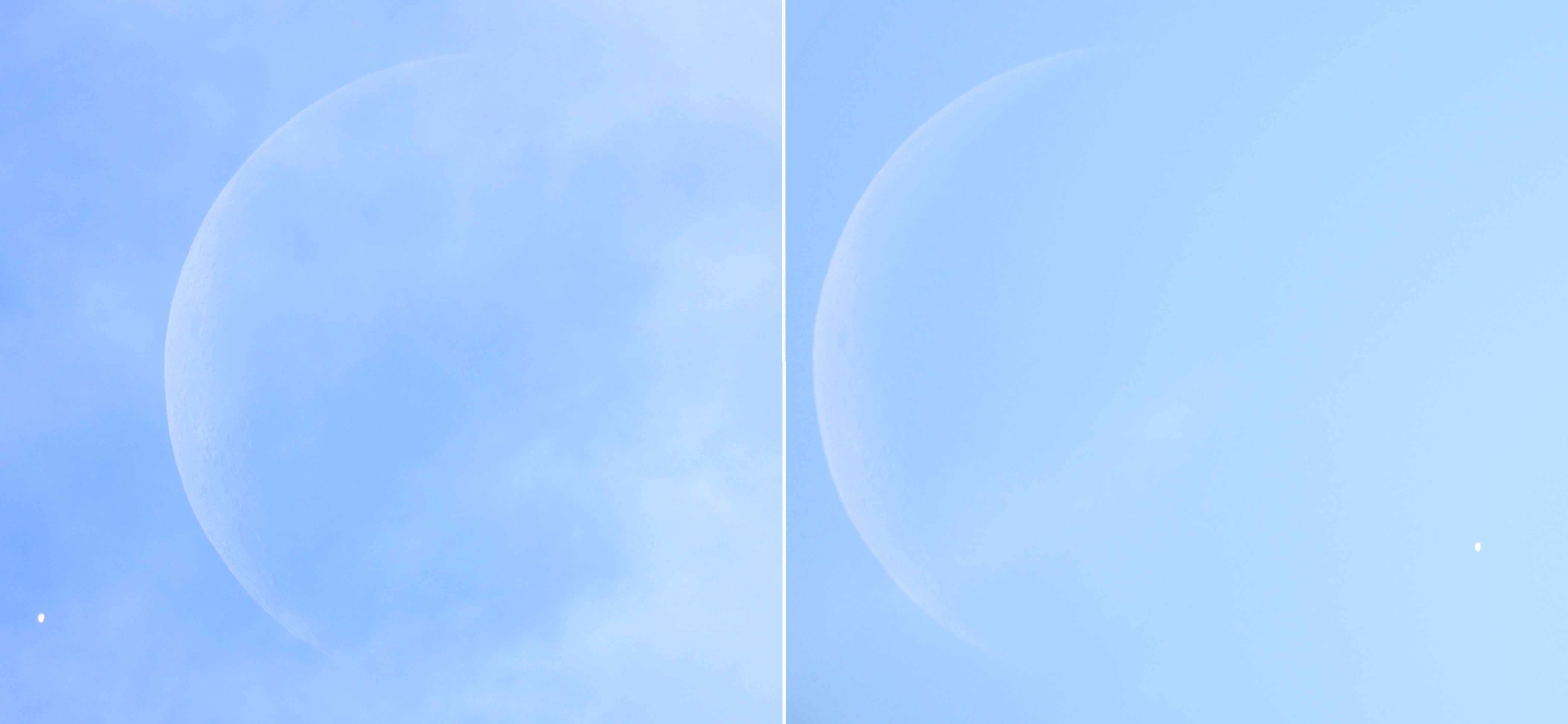 L: 10:16 UT, before disappearance; R: 10:59 UT, after reappearance.
L: 10:16 UT, before disappearance; R: 10:59 UT, after reappearance.Orwell Astronomical Society (Ipswich)
Lunar Occultations Of Planets, 02 March 1974 - 09 November 2023
Introduction to lunar occultations.
Observations by members of OASI of lunar occultations of planets are reported below.
On 09 November 2023, the Moon occulted Venus. Several members of OASI attempted observations of the event.
Table 1 lists predicted circumstances for Orwell Park Observatory. Event times refer to the centre of the planetary disk; the disk was predicted to take approximately 80 seconds to disappear and reappear.
Detail
Prediction
Table 1. Predicted circumstances of lunar occultation of Venus.
The weather was not favourable, with much cloud present, and the event took place in broad daylight.
Observing reports from members of OASI are below.
Unfortunately, cloud appeared 20 minutes before disappearance and persisted until five minutes after reappearance. I managed to take images before the cloud appeared and again after it dispersed. The following images were taken at 10:16 UT and 10:59 UT with a Skywatcher 200P and Canon 850D camera. The phase of Venus is visible in the images below (when viewed at full resolution).
 L: 10:16 UT, before disappearance; R: 10:59 UT, after reappearance.
L: 10:16 UT, before disappearance; R: 10:59 UT, after reappearance.
Venus clearly visible to the naked eye, by the dark limb of the Moon, a lovely sight.
Just seen Venus through binoculars, just after occultation reappearance. Nice and bright.
My morning (times are UT):
09:30 The telescope was set up. The sky was completely clear other than a little cloud around the sun (no bad thing). I could see the Moon and Venus clearly and decided to wait a few minutes before taking an image.
09:35 A wisp of cloud covered the Moon and Venus, but there was not not much more cloud around. It was windy though.
09:40 Cloud moved in fast. Solid cloud covered the Moon and Venus. To the SW, from where it was blowing in, no gaps were visible, and in the distance, thick, dark cloud was approaching. Indeed, it shortly began to rain. I packed everything away.
10:35 The rain stopped and in the distance there were ribbons of blue sky. Would the sky be clear for the reappearance?
11:00 The clear patches didn't make it this far, and the sky was completely cloudy.
On the morning of 08 December 2022, the Moon occulted Mars. Table 1 lists predicted circumstances for Orwell Park Observatory (event times refer to the centre of the planetary disk).
Detail
Prediction
Table 1. Predicted circumstances of lunar occultation of Mars.
After several weeks of poor weather, the sky cleared on the night of 07-08 March. I videod the occultation disappearance of Mars by the Moon; unfortunately, the altitude of Mars at reappearance, approximately one hour later, was too low for me. The Moon was less than one hour after full at the time of disappearance. Mars exhibited a diameter of 17 arcseconds.
The clip below is speeded-up by a factor of five, so the disappearance, which took some 35 seconds, in the video is over in only seven.
On 22 May 2007, the Moon occulted Saturn. The occultation was the second of the planet during the year, the earlier one having occurred on 02 March. The occurrence of two such rare events within a period of only two and a half months stimulated more than usual interest, and several members of OASI attempted observations of the event.
Table 1 lists predicted circumstances for Orwell Park Observatory (event times refer to the centre of the planetary disk).
Detail
Prediction
Table 1. Predicted circumstances of lunar occultation of Saturn.
Conditions were not ideal, as the disappearance event took place with the Sun above the horizon and the reappearance event took place during twilight.
Observing reports from members of OASI are below.
Equipment: 25 cm F5.4 Dobsonian with 18 mm eyepiece.
After receiving a phone call from Alan Smith at 7.15pm asking why he could not see Saturn, I thought that I might have missed the occultation! However, quickly checking details on the ephemeris package Starry Night I found that the occultation did not start until approximately 19:10 UT. So I set up my telescope and found Saturn. Then I phoned Alan to inform him that he needed to look in the right place and buy a decent telescope!
There was slight high level cloud. The sky was very bright and Saturn appeared very washed out, making timing very difficult. However, I persevered and recorded the times shown in table 2.
Time (UT)
Observation
Table 2. Event timings.
I took the following photograph from the eyepiece with an Olympus C765 digital camera. It shows Saturn (indicated) just after reappearance.
Equipment: 250 mm Newtonian, approx. 1000 mm focal length, 6 mm Orthoscopic eyepiece.
Seeing very poor, contrast very low. Saturn swimming in and out of focus, but Cassini Division just visible. Details visible on the globe of Saturn and on the lunar surface. It's been a while since I had the covers off the telescope and I'm a bit out of practice! Table 3 lists my recorded timings.
Time (UT)
Observation
Table 3. Event timings.
Equipment: 200 mm Fullerscope Newtonian, focal length 1225 mm, using 40 mm and then 12.5 mm eyepiece (magnifications 30x and 98x approx).
I observed the occultation, but did not time it. Before the disappearance event, I could not see Saturn in binoculars and so got my telescope out to observe the event. This was the first time for daylight observing with my kit.
After some time I found Saturn, about five minutes before disappearance, using a 40 mm eyepiece. Mrs P found Saturn difficult to spot, but when she found it she said that it was pretty against the light sky. Just over an hour later, after Saturn emerged from behind the Moon, she said that it was quite a "wow" against the bright lunar limb.
The Cassini Division in the rings and some planetary details were just visible. The seeing was reasonable at times, but the Moon appeared to be "boiling".
Then I observed Venus at half phase; both I and Mrs P noted the phase. And then it clouded over. Phew just made it!
Equipment: 18x50 binoculars, with stabilisation mechanism.
Conditions: sky very bright, mainly clear but with some cirrus and many vapour trails.
The crescent lunar phase meant that problems due to glare from the Moon were reduced. However, ingress at 20:04 UT was very difficult to observe with the binoculars owing to the brightness of the sky (the Sun was still above the horizon). Reports from observers with larger telescopes indicated that the disappearance of Saturn appeared to be much quicker than anticipated, probably due to the ambient light making observation difficult.
Egress at 21:11 UT was much easier to observe as the Sun had set by this time. The reappearance of the rings is always a magical sight and so it was on this occasion. Easily observed in binoculars.
I also observed, in the twilight, Venus at half phase, Mercury and a nice display of Earth-shine on the dark side of the Moon.
On 02 March 2007, the Moon occulted Saturn. Table 4 lists predicted circumstances for Orwell Park Observatory (event times refer to the centre of the planetary disk).
Detail
Prediction
Table 4. Predicted circumstances of lunar occultation of Saturn.
The predictions indicated that Saturn would disappear behind the lunar limb approximately 4°W of the S Pole, in the crater Cabeus. The relatively short duration of the occultation and the southern limb aspect promised a view of Saturn appearing to slide behind features on the lunar limb at a glancing angle. (Indeed, from further west in the UK the phenomenon was visible as a grazing occultation.)
I observed the lunar occultation of Saturn using a Meade 250 mm SCT with 18 mm eyepiece. The sky was a little hazy, but reasonably transparent - the magnitude 4.0 star η Corvi (at an altitude of only 20°) was easily visible to the naked eye despite the almost full Moon. Predictions indicated that first contact of the disk of Saturn against the Moon would occur on the dark lunar limb only 10° from the bright cusp. However, in practice, undulations on the terminator meant that first contact occurred against an illuminated limb and, in the eyepiece, the planet appeared to move east to west along the limb, behind bright and dark features, before finally disappearing.
At 02:00 UT, I completed setting up and aligning my telescope. At first it took a few seconds to locate Saturn by naked eye against the glare from the Moon. In the telescope, Saturn was visible along with Titan and a slightly fainter field star closer to the Moon. I thought I glimpsed a faint moon of Saturn close to the following ring ansa, but was unsure - later investigations with the planetarium program Redshift 5 indicated that this may have been Mimas. Glare from the Moon was a problem, although by adjusting the amount of the lunar disk in the field of view and the orientation of the eye in relation to the eyepiece, it was possible to minimise problems.
Thirty minutes later, the temperature of the telescope had fallen close to ambient, and definition was much improved. The Cassini division in Saturn's rings and a band on the planet's surface were easily visible. Saturn appeared much closer to the Moon and I could not see Titan due to glare from the Moon. The colour contrast between Saturn and the Moon was most pronounced: the Moon appeared dazzlingly white, whereas Saturn in contrast appeared dusky and pale.
Table 5 lists event times estimated using a stopwatch set to the speaking clock.
Time (UT)
Observation
Table 5. Event timings.
I made a sketch of the event at the eyepiece and took some photographs. The sketch is corrected to give a true naked-eye orientation; it shows the movement of Saturn from W to E along the lunar limb during the disappearance event. The photographs were taken with a Minolta Dynax 500 Si camera in afocal mode with 200 ASA print film, using a range of exposure times from 0.5 to 2.0 seconds. Images are below.
I observed the occultation and acquired images using my 34 cm F/4.0 Newtonian with 2x Barlow and Starlight Xpress MX916 CCD. I used exposure times of ~1/100 s to register Saturn but this resulted in a very overexposed lunar image. By processing the images so that both Saturn and the lunar limb were visible it was apparent that Saturn passed behind the illuminated central peak of the crater Cabeus shortly before disappearing.
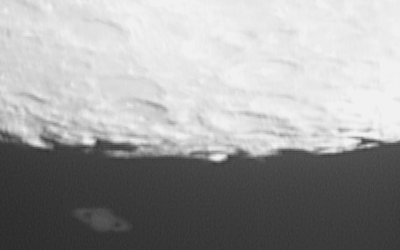 Animation of occultation.
Animation of occultation.
Set alarm for 02.25 UT and started setting up my 250 mm Dobsonian at 02.35 UT. Moon and Saturn were easy to find. Titan was the only moon of Saturn visible. The planet itself looked rather washed out/low contrast due to the glare of the full moon. Table 6 lists my recorded event times. By the time of reappearance I was cold and tired through driving the telescope manually!
Time (UT)
Observation
Table 6. Event timings.
Enjoyed very good views of the event. Set up my equipment at 23:00 UT: Meade LX 50 (200 mm Schmidt-Cassegrain) and 8x42 binoculars on a stand. Saturn looked good. Still good at midnight. Went to bed for two hours and resumed observations at 02:00 UT. View still good, but signs of dew on objective of LX 50 despite dew cap. Observed initial contact at 02:38:18 UT. Alas dew then took over and, although the Moon was visible, Saturn's reappearance was not! The binoculars however, which I had covered with a cloth for the two hours during which I was in bed, showed Saturn when several arcsec clear of the lunar limb. I regretted not covering the LX 50 similarly! All in all, a good session.
While most interest in Venus around mid-2004 was focussed on the transit on 08 June, just three weeks earlier, on Friday 21 May, there occurred a lunar occultation of the planet, which held interest for keen observers. Bill Barton, Garry Coleman and I decided to attempt an observation.
The occultation was forecast to take place at 11:09 UT, with the bodies only 22° from the Sun (the Moon being only two days old). Both the Moon and Venus can be observed during the day, the former generally easily, the latter if you employ a telescope and know where to look. However, we anticipated difficulty in finding the planet due to the Sun's glare; a back garden observation would be difficult and we therefore intended to observe using the Tomline Refractor.
Some preparation was clearly required. Therefore, on the evening of Wednesday 19 May, at Orwell Park Observatory, we practised locating Venus in proximity to the Sun. Bill used data from the BAA Handbook to calculate the RA and dec of both the Sun and Venus. This enabled us to centre the Tomline Refractor on the Sun (via projection of the solar image on a piece of white card held behind the eyepiece) and then move the instrument by the appropriate offset to find Venus. This approach worked satisfactorily and we intended to use it again on 21 May.
At 10:00 UT on 21 May, I joined Bill and Garry in the dome at Orwell Park. Bill had again calculated the RA and dec of the Sun and Venus. The sky was briefly clear before 11:00 UT enabling us to project the Sun's image onto white card, read the RA from the telescope's setting circle (the brass drive wheel at the base of the instrument), and move the instrument in RA and dec by the necessary amounts (1h 46m in RA and 6° N in dec) to centre it on Venus. Alas, by the time we had re-positioned the telescope, the sky had clouded over, and it remained cloudy for the entire period of the occultation. We didn't see Venus.
However, Bill, being very determined, insisted that we keep the telescope drive runnning for another half hour after the occultation ended at 12:19 UT, because "a clear patch of sky was coming". And he was right: the sky cleared and we saw Venus in the eyepiece with the Moon a large fraction of a degree beyond it! So, we had missed the occultation, but our technique for positioning the telescope on the planet had been accurate.
It was a difficult and interesting observing project, and quite different from the forthcoming transit on 08 June 2004.
On 16 April 2002, the Moon occulted Saturn, with disappearance at 20:57 UT and reappearance at 21:27 UT as viewed from Orwell Park Observatory. The Moon was young (phase 15%, waxing) and therefore its illuminated portion did not create too much glare. As a result, Saturn, its rings and its largest satellite, Titan, were easily visible telescopically as the Moon approached. Two members of OASI observed the occultation.
This was my first observation of a lunar occultation of a planet. I tried photographing the event using a 1000 mm telephoto and a Meade ETX 90. To get a regularly spaced set of photos I used the 555-based timer that I used subsequently for solar eclipse photography. It took a couple of minutes for the Moon to completely obscure Saturn and I successfully recorded a pair of sequences, although one camera ran out of film the instant Saturn disappeared.
Equipment: 114 mm F8 Orion Newtonian reflector with RA motor drive. Eyepiece projection using 20 mm eyepiece and camera adapter onto 35 mm film via Pentax camera body. Adjusted so that Moon fills 75% height of frame. Manual cable release shutter. 400 ASA Fujichrome slide film.
Exposures: Approximately 1 second for all images shown below (best compromise from bracket range of ¼ to 4 seconds). Slides scanned at 800 dpi on Epson 1660 scanner.
Seeing conditions: at start of occultation (20:58 UT) - medium clear but rather turbulent. At end of occultation (21:27 UT) - very turbulent, subject sinking into orange sky glow near horizon.
Imaged with a Celestron C8 reflector.
Two lunar occultations of Saturn occurred in 2001 during the hours of darkness. Table 7 provides summary details (times refer to the middle of the planetary disk).
| Date | Time (UT) |
D R |
Lunar Phase |
Sun Alt (°) |
Planet Alt (°) |
Mag |
| 03 Nov 2001 | 21:05:35 | D | 0.92- | -42 | 27 | -0.3 |
| 22:03:31 | R | -49 | 36 | |||
| 01 Dec 2001 | 02:25:44 | D | 1.00- | -47 | 47 | -0.4 |
| 03:35:15 | R | -37 | 37 |
Table 7. Occultations of Saturn during hours of darkness in 2001.
Members of OASI reported observations as follows of the first occultation of the pair.
I observed the last lunar occultation of Saturn (12 November 1997) visually so thought that I would try photography on this occasion. I used a 25 cm Meade LX-200 Schmidt-Cassegrain with an 18 mm eyepiece and took photographs at the eyepiece with a standard 35 mm SLR camera (afocal method). As usual with this approach, aligning the camera and telescope proved to be the biggest practical difficulty! An exposure of a second or so was necessary to capture Saturn's rings and, during the disappearance phase, with the bright limb of the Moon obscuring Saturn, this resulted in a very over-exposed lunar limb with no detail visible on the surface. During the reappearance phase, a relatively small proportion of the illuminated fraction of the Moon was present in the frame so glare was much reduced and detail on the lunar surface was visible together with the planet.
During the disappearance event seeing conditions were mediocre and there was considerable haze due to early fireworks celebrating Guy Fawkes' Night on 05 November! However, during the reappearance event, seeing conditions were excellent and the atmosphere was extremely still and transparent. I took only a couple of photographs during the reappearance and instead enjoyed the view at the eyepiece. The Cassini division in Saturn's rings was very prominent and I could also clearly see a large dark, equatorial band on the planet's surface. At 22:30 UT I noticed Saturn's largest moon, Titan, midway between the planet and the lunar terminator. Although Titan is a magnitude 8.1 object it was nevertheless clearly visible despite the close proximity of the bright portion of the lunar disk.
A selection of photographs is below.
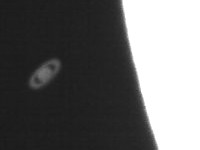 20:45 UT, shortly before disappearance. One second exposure.
20:45 UT, shortly before disappearance. One second exposure.
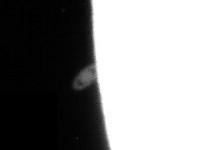 21:05 UT
21:05 UT
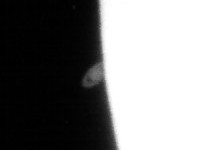 Seconds later.
Seconds later.
Having mistakenly agreed to a supper invitation with friends on Saturday night, I knew that to turn up with my Meade LX 50 would be deemed bad form! However, binoculars on a stand from the bathroom window of a terraced house in Manningtree was better than nothing and gave a good opportunity to observe the approach towards disappearance and involve the host and other guests in the excitement.The firework display in the garden next door was a greater attraction for some. Some others only humoured me, but one or two were keen enough to return to the viewing location for the reappearance. But as we know, something is interesting if you find it so!
Although my home in Tuddenham is in a rural location, it is situated on the southern side of the Fynn Valley and fog/smoke tends to linger in the depression. I was discouraged from setting up my 250 mm reflector by occasional drifting cloud and smoke from several local firework party bonfires. However, by around 10.00pm most of the firework spectators had retired and I was able to watch the planet through binoculars as it passed out of a halo around the Moon - a fine sight, which made me regret not properly setting up.
Following a glass of red wine I managed to dash out of the front door and hastily set up my recently acquired Orion 114 mm reflector just in time to see Saturn touch and then slide behind the Moon. Returning indoors to finish off the wine I emerged an hour later, having left the scope out, to much better viewing - no doubt the optics had come to thermal equilibrium, plus the Moon was higher in the sky. (Ed: Plus no doubt the extra wine had improved Mike's eyesight!) I was very struck by the tiny and almost fragile appearance of Saturn compared to the rugged lunar surface, and the thought that in reality Saturn could swallow the Moon many times over!
We saw the disappearance and reappearance events using a 60 mm refractor and a 200 mm f/5.2 home-constructed Dobsonian. Disappearance was nice to see but nothing special, although the contrast in surface brightnesses between the Moon and Saturn was very noticeable. Reappearance on the other hand was spectacular. The tip of the wide open rings appeared in dark sky well away from the bright surface of the Moon. Seconds later the detached crescent of the rings hung in space before the ball of the planet started to appear. Eventually the planet and rings became visible with the Cassini division, southern equatorial belt and dusky polar region well seen. Well worth going out for...
The disappearance was clouded out in Bristol. Nicky and I called a friend in Devon who reported a clear sky so we headed a little way south-west from the city to see if we could get out from under the cloud. We arrived at Kenn in North Somerset at around 10.00pm in time for the reappearance. At Kenn, the cloud was sufficiently broken for the ETX to reveal the Moon just before reappearance and again just after it with Saturn close to the dark limb.
I observed from Kesgrave with a 114 mm reflector. The sky was clear for both disappearance and reappearance but the Moon was surrounded by a misty glow making observation of Titan impossible. I saw the rings of Saturn very clearly and both disappearance and reappearance of the planet behind the Moon were spectacular (my first observation of such an event). The precise positions and timings of the event were in excellent agreement with a simulation on the Starry Night computer ephemeris program.
David and Martin had arranged to observe the occultation from Orwell Park Observatory. David planned to video the event using the 26 cm Tomline Refractor while Martin would observe visually using the 25 cm Dobsonian reflector. The pair arrived at the Observatory at about 8.00pm and began setting up the instruments and a camcorder. Initially, David intended to use the Society's low-light monochrome camera to image the event and to use his camcorder simply as a means of recording the image thus produced. However, while waiting for the occultation to take place, he decided to try the camcorder on the Moon, employing afocal coupling (basically, replacing the eye at the eyepiece with the camcorder). Using a 50 mm Lanthanum eyepiece to give the largest Ramsden disc at the eyepiece and with the controls set to manual, he was able to over-expose the Moon even at full magnification; this gave some hope that the video camera would be able to record Saturn directly (without the need to employ the low-light camera). Re-positioning the telescope to view Saturn, he found that this was indeed the case, and that the images of Saturn were clear and sharp. Accordingly, David changed plan and decided to use the camcorder afocally coupled to the Tomline Refractor to record the event.
Adapters to connect video cameras to the Tomline Refractor had not at this date been fabricated, so it was necessary for David to hand-hold the camcorder throughout the observation. In fact, holding the camera and operating the controls necessitated two hands, meaning that it was not possible to maintain accurate optical alignment between the telescope and the camera and keep the image of Saturn in the centre of the field of view of the camera, particularly when operating the zoom control. The experience highlighted the need for an adapter!
As the time of occultation disappearance approached, there was some atmospheric turbulence but the seeing was otherwise good. First contact was estimated from single frame stepping at 21:04:54 UT, although the turbulence made it very difficult to estimate the time exactly. By the time of the reappearance, approximately one hour later, all cloud had disappeared and there was good contrast for the images. the reappearance was particularly spectacular, Saturn emerging from blackness and hanging apparently severed in space. The reappearance time, estimated from single frame stepping, was 22:02:42 UT.
The images shown below are stills captured from the video. In many of the disappearance images, the Moon is over-exposed in the centre of the field but darkens towards the edge of the Ramsden disk due to vignetting. There is a blue band on the bright limb of the Moon due to chromatic aberration in the object glass of the Tomline Refractor (it is not fully corrected in the blue region). The images have been rotated through 180° to make them correspond to the naked eye view: unfortunately, this means that dates and timestamps are also rotated!
On 02 March 1974, the Moon occulted Saturn. Table 8 lists predicted circumstances for Orwell Park Observatory (event times refer to the centre of the planetary disk).
Detail
Prediction
Table 8. Predicted circumstances of lunar occultation of Saturn.
Orwell Park Observatory was open to observe the event. Approximately ten people attended and report that they had a great time: it was a thrilling sight watching the satellites of Saturn disappear one by one behind the dark edge of the Moon, followed by the planet itself. The observers also watched reappearances. I understand too that Nigel Gage supplied refreshments to keep out the cold!